| Governance
in Spanish America was, on the surface, a top down
affair. City life was punctuated by reminders of the
centrality of the king and his representative, the
viceroy. Across the whole colonial period, city dwellers
were called out from their homes by noisy processions
to welcome a new viceroy, celebrate the birth of a
royal heir or mourn the death of their king. These
events—surprising and irregular—were extravagantly
commemorated and they also afforded spectators a visual
lesson on politics.
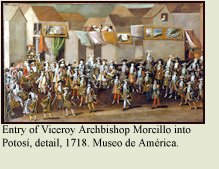 The
position of participants in the parade signaled their
importance in this political hierarchy, even beyond
the elegance and color of their clothing or the weight
of their swords. Members of the Audiencia, the judicial
branch of the Spanish government, would ride grandly
on horseback, as would the Viceroy, while alcaldes,
or councilmen, might follow on foot. And the morning
after, city dwellers were again reminded of their
role in this system when tax collectors knocked at
their doors to have them foot the bill. The
position of participants in the parade signaled their
importance in this political hierarchy, even beyond
the elegance and color of their clothing or the weight
of their swords. Members of the Audiencia, the judicial
branch of the Spanish government, would ride grandly
on horseback, as would the Viceroy, while alcaldes,
or councilmen, might follow on foot. And the morning
after, city dwellers were again reminded of their
role in this system when tax collectors knocked at
their doors to have them foot the bill.
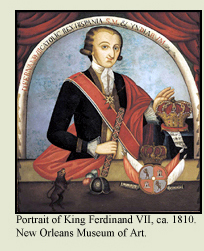 This
section of Vistas focuses on visible things
left by these shows of political power. Perhaps least
surprising are the portraits of kings, from painted
versions that adorned the walls of elegant houses
to engraved versions on coins that circulated from
royal mint to country market. Second in power to the
monarch were his appointed viceroys, whose portraits
mimicked those of the king. Yet images of the mighty
were not the most important ways in which political
power was made visible. Political power could be embedded
in and enacted through the use of maps of territory,
staffs of office and government palaces. These works
do not merely reflect the power resulting from governance.
Rather, these objects and visual displays had agency—that
is, leaders used pageants, buildings and paintings
to refresh their audience’s understanding of
the political hierarchy. While some scholars interpret
these events and objects as propaganda, foisted by
an arrogant ruling class onto the populace at large,
this represents a too-narrow view. In order to be
absorbed into visual culture and preserved over time,
staffs of office and royal portraits depended on a
willingness of the governed, as well as those governing,
to participate in the rituals that cleaved people
to rulers. This
section of Vistas focuses on visible things
left by these shows of political power. Perhaps least
surprising are the portraits of kings, from painted
versions that adorned the walls of elegant houses
to engraved versions on coins that circulated from
royal mint to country market. Second in power to the
monarch were his appointed viceroys, whose portraits
mimicked those of the king. Yet images of the mighty
were not the most important ways in which political
power was made visible. Political power could be embedded
in and enacted through the use of maps of territory,
staffs of office and government palaces. These works
do not merely reflect the power resulting from governance.
Rather, these objects and visual displays had agency—that
is, leaders used pageants, buildings and paintings
to refresh their audience’s understanding of
the political hierarchy. While some scholars interpret
these events and objects as propaganda, foisted by
an arrogant ruling class onto the populace at large,
this represents a too-narrow view. In order to be
absorbed into visual culture and preserved over time,
staffs of office and royal portraits depended on a
willingness of the governed, as well as those governing,
to participate in the rituals that cleaved people
to rulers.
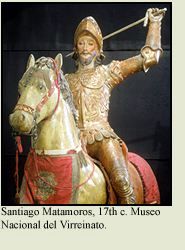 One
metaphor that runs through discussions of politics
and its visual expression is war, no doubt because
it was both the alpha and omega of political order:
wars of conquest preceded government, and wars followed
when government failed. In the early years of the
16th century, war and governance were inseparable.
The conquistadors, the first Spaniards to wrest governance
away from indigenous rulers in the Americas, were
hardened soldiers. Early viceroys, like Antonio de
Mendoza, likewise needed to wield the sword as well
as the scepter. In most cases, though, the powerful
were content merely to invoke the iconography of war,
rather than actually wage war. Devotion to Santiago
Matamoros, St. James the Moor-slayer, played a deep
and lasting role in Spanish America. Across the colonies,
his image, mounted upon a horse ready for battle,
was painted, sculpted, and, upon occasion, carried
into the streets during processions. One
metaphor that runs through discussions of politics
and its visual expression is war, no doubt because
it was both the alpha and omega of political order:
wars of conquest preceded government, and wars followed
when government failed. In the early years of the
16th century, war and governance were inseparable.
The conquistadors, the first Spaniards to wrest governance
away from indigenous rulers in the Americas, were
hardened soldiers. Early viceroys, like Antonio de
Mendoza, likewise needed to wield the sword as well
as the scepter. In most cases, though, the powerful
were content merely to invoke the iconography of war,
rather than actually wage war. Devotion to Santiago
Matamoros, St. James the Moor-slayer, played a deep
and lasting role in Spanish America. Across the colonies,
his image, mounted upon a horse ready for battle,
was painted, sculpted, and, upon occasion, carried
into the streets during processions.
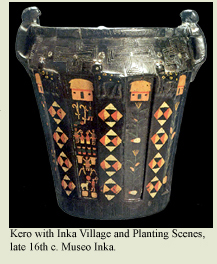 But
political power and the obligations of governance
were not just the province of Spaniards and Creoles.
From the time of the conquest of Mexico, Spaniards
built the colonial state upon pre-existing systems
of native governance. While the Spaniards gave indigenous
leaders new titles and rites of rule, they were reluctant—and
probably unable—to dismantle their political
systems completely. In the 16th century, many local
town governments were run by native men who conducted
meetings in their native tongues with little interference
or involvement from outsiders. And objects associated
with pre-Hispanic political and religious power, such
as drinking cups from the Andes known as keros, were
still exchanged as political gifts and displayed in
public feasts even as they took on new meanings and
imagery. Indeed, it comes as little surprise that
these objects did not remain static in their importance
because native systems of governance continued to
develop throughout the colonial period. But
political power and the obligations of governance
were not just the province of Spaniards and Creoles.
From the time of the conquest of Mexico, Spaniards
built the colonial state upon pre-existing systems
of native governance. While the Spaniards gave indigenous
leaders new titles and rites of rule, they were reluctant—and
probably unable—to dismantle their political
systems completely. In the 16th century, many local
town governments were run by native men who conducted
meetings in their native tongues with little interference
or involvement from outsiders. And objects associated
with pre-Hispanic political and religious power, such
as drinking cups from the Andes known as keros, were
still exchanged as political gifts and displayed in
public feasts even as they took on new meanings and
imagery. Indeed, it comes as little surprise that
these objects did not remain static in their importance
because native systems of governance continued to
develop throughout the colonial period.
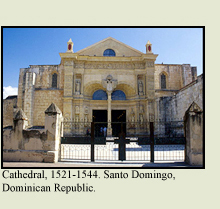 Many
objects and documents bind temporal political power
to divine power. Such unions had deep roots in Spain
and the Americas. In Spain, rulers were believed to
receive their right to rule through a contract with
the people that was sanctioned by God and the Catholic
Church. And likewise, the rulers of pre-Hispanic states
were held to have divine or semi-divine status. Cathedrals,
such as those in the major cities of Lima, Mexico,
Puebla, Santo Domingo and Antigua, were not strictly
buildings for prayer. They also housed the remains
of conquistadors and the masses celebrating the consecration
of kings and viceroys. And most cathedrals opened
their doors onto the central plazas of Spanish America’s
capital cities, sharing pride of place with other
prestigious government buildings. Many
objects and documents bind temporal political power
to divine power. Such unions had deep roots in Spain
and the Americas. In Spain, rulers were believed to
receive their right to rule through a contract with
the people that was sanctioned by God and the Catholic
Church. And likewise, the rulers of pre-Hispanic states
were held to have divine or semi-divine status. Cathedrals,
such as those in the major cities of Lima, Mexico,
Puebla, Santo Domingo and Antigua, were not strictly
buildings for prayer. They also housed the remains
of conquistadors and the masses celebrating the consecration
of kings and viceroys. And most cathedrals opened
their doors onto the central plazas of Spanish America’s
capital cities, sharing pride of place with other
prestigious government buildings.
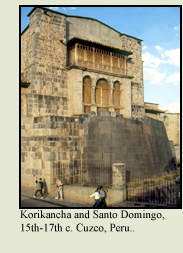 In
fact, residents of Spanish America really lived under
the domain of two overlapping governments, one run
by the Crown, the other by the Church. In many regards,
the two were inseparable. Early on, for instance,
the conquest of territory and political empire proceeded
hand-in-glove with the conversion of native people.
The physical and visual traces of this enterprise
remain. Just as Santo Domingo rises out of the foundations
of the Korikancha, many other churches were built
on top of the foundations of indigenous temples. In
addition, large monastic complexes were built under
the supervision of friars in the 16th century. This
same enterprise was still alive in the 18th century,
as missions were built in Texas and California. Across
the colonial period, the desire to evangelize and
civilize always bound Church and state. In
fact, residents of Spanish America really lived under
the domain of two overlapping governments, one run
by the Crown, the other by the Church. In many regards,
the two were inseparable. Early on, for instance,
the conquest of territory and political empire proceeded
hand-in-glove with the conversion of native people.
The physical and visual traces of this enterprise
remain. Just as Santo Domingo rises out of the foundations
of the Korikancha, many other churches were built
on top of the foundations of indigenous temples. In
addition, large monastic complexes were built under
the supervision of friars in the 16th century. This
same enterprise was still alive in the 18th century,
as missions were built in Texas and California. Across
the colonial period, the desire to evangelize and
civilize always bound Church and state.
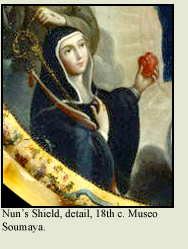 The
lack of political power was also conveyed through
the visual. Women carried parasols, not staffs; plantation
slaves wore few clothes. Most indigenous men were
forbidden to ride on horseback and carry swords, both
the distinguishing prerogatives of soldiers and gentlemen.Yet
the general lack of political power held by women
and native peoples should not be read as a perpetual
void. Women could wield political power within the
protective shelter of convents, where they could lead
communities, oversee the conduct of novices and control
the often-considerable sums that were communal assets.
Indigenous men, especially elite and educated ones,
could hold public office in their own communities,
head religious societies called cofradías,
and exert considerable sway in local affairs. The
lack of political power was also conveyed through
the visual. Women carried parasols, not staffs; plantation
slaves wore few clothes. Most indigenous men were
forbidden to ride on horseback and carry swords, both
the distinguishing prerogatives of soldiers and gentlemen.Yet
the general lack of political power held by women
and native peoples should not be read as a perpetual
void. Women could wield political power within the
protective shelter of convents, where they could lead
communities, oversee the conduct of novices and control
the often-considerable sums that were communal assets.
Indigenous men, especially elite and educated ones,
could hold public office in their own communities,
head religious societies called cofradías,
and exert considerable sway in local affairs.
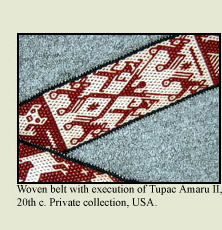 It
is the objects and buildings produced for the established
political institutions—the Spanish state and
the Catholic Church—that have been best preserved.
Still others outside this circle used the visual to
aid in their contests for political power. Rebel leaders,
for example, often commandeered the established visual
expressions of political power. When the Andean rebel
Tupac Amaru II first seized power in 1780, he staged
an elaborate public execution of the Spanish corregidor,
to show his take-over of the viceregal justice system.
He also came to refer to himself as the Inka, a name
that called up the specter of pre-Hispanic rulership.
That his rebellion did not succeed is, in certain
respects, just one piece of the story. For Tupac Amaru’s
ambitions and grisly demise were commemorated via
paintings and weavings like this 20th-century example,
as well as in written texts and oral narratives. It
is the objects and buildings produced for the established
political institutions—the Spanish state and
the Catholic Church—that have been best preserved.
Still others outside this circle used the visual to
aid in their contests for political power. Rebel leaders,
for example, often commandeered the established visual
expressions of political power. When the Andean rebel
Tupac Amaru II first seized power in 1780, he staged
an elaborate public execution of the Spanish corregidor,
to show his take-over of the viceregal justice system.
He also came to refer to himself as the Inka, a name
that called up the specter of pre-Hispanic rulership.
That his rebellion did not succeed is, in certain
respects, just one piece of the story. For Tupac Amaru’s
ambitions and grisly demise were commemorated via
paintings and weavings like this 20th-century example,
as well as in written texts and oral narratives.
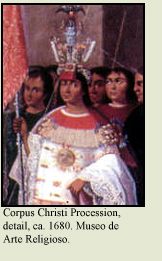 Such
evocation of the political order of pre-Hispanic empires
became integral to visual displays of power in Spanish
America. And it was the empires felled by the Spanish
conquest—the Aztec in New Spain, and the Inka
in Peru—that were most often evoked. To suggest
the unbroken progression of imperial governance, floats
and triumphal arches celebrating new Spanish kings
included images of the imperial Inka or alluded to
the royal Aztecs of the past. And on colonial feast
days in the Andes, elites who could trace their descent
from ancient Inka royalty proudly wore elaborately
embroidered tunics along with the maskapaycha,
a scarlet fringe across their foreheads that had once
been the crown of office of the supreme Inka.
Such
evocation of the political order of pre-Hispanic empires
became integral to visual displays of power in Spanish
America. And it was the empires felled by the Spanish
conquest—the Aztec in New Spain, and the Inka
in Peru—that were most often evoked. To suggest
the unbroken progression of imperial governance, floats
and triumphal arches celebrating new Spanish kings
included images of the imperial Inka or alluded to
the royal Aztecs of the past. And on colonial feast
days in the Andes, elites who could trace their descent
from ancient Inka royalty proudly wore elaborately
embroidered tunics along with the maskapaycha,
a scarlet fringe across their foreheads that had once
been the crown of office of the supreme Inka.
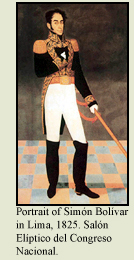 By
the end of the 18th century, Creole leaders as well
as indigenous people had grown impatient with the
yoke of colonial rule. Yet the declaration of independence
by the colonies of Spanish America and their transformation
into Latin American nations in the early 19th century
followed no single trajectory, either politically
or visually. In the image of Simón Bolívar,
a leader in the Wars of Independence, it seems that
the tradition of royal portraits was not simply ignored,
but rather transformed into a Republican one. Likewise,
indigenous political accoutrements and symbols familiar
from colonial times were still used in the wake of
independence; few peoples erase the rituals or emblems
of the past completely. Through the 19th century,
well after Independence, the freshly minted nations
of Latin America would come to develop their own visual
expressions for the new contours of their political
power. By
the end of the 18th century, Creole leaders as well
as indigenous people had grown impatient with the
yoke of colonial rule. Yet the declaration of independence
by the colonies of Spanish America and their transformation
into Latin American nations in the early 19th century
followed no single trajectory, either politically
or visually. In the image of Simón Bolívar,
a leader in the Wars of Independence, it seems that
the tradition of royal portraits was not simply ignored,
but rather transformed into a Republican one. Likewise,
indigenous political accoutrements and symbols familiar
from colonial times were still used in the wake of
independence; few peoples erase the rituals or emblems
of the past completely. Through the 19th century,
well after Independence, the freshly minted nations
of Latin America would come to develop their own visual
expressions for the new contours of their political
power.

|
